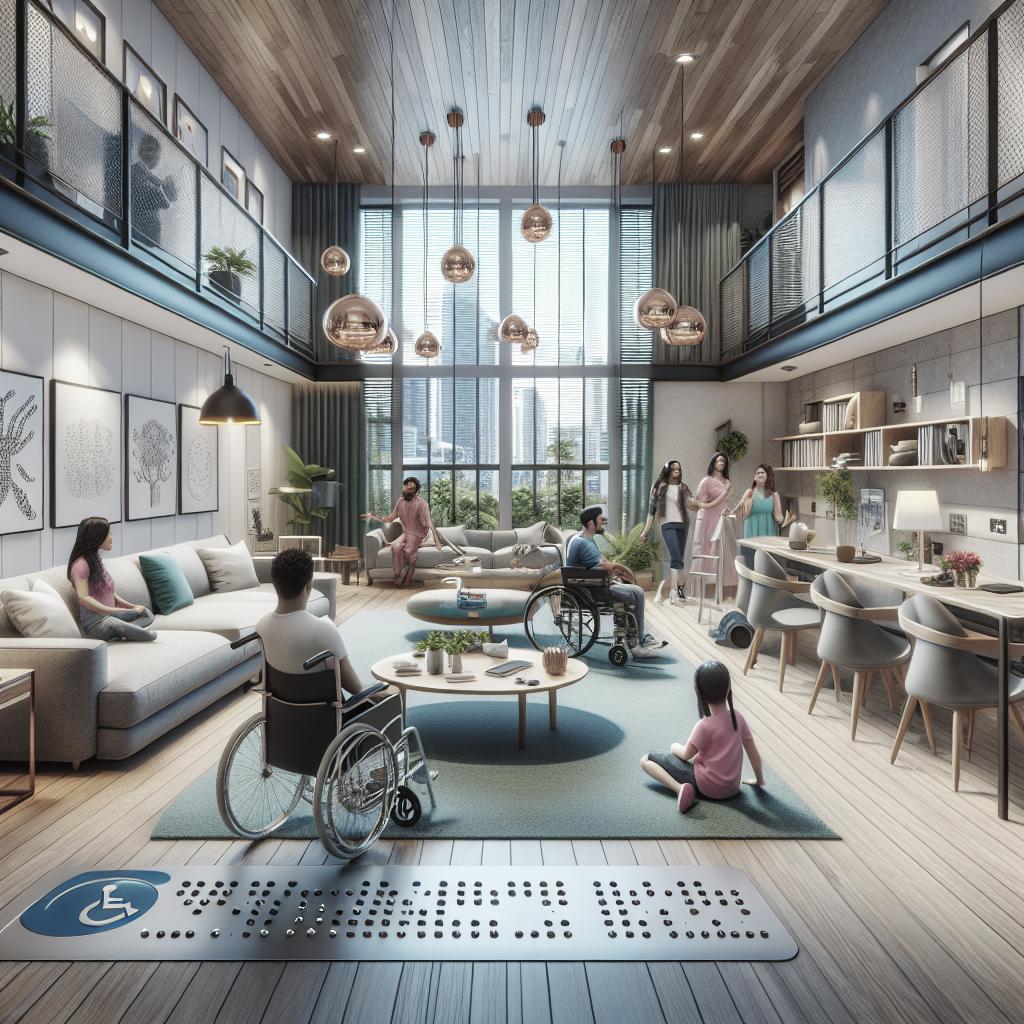Designing an inclusive living space is an essential consideration in modern home design, aiming to ensure accessibility and comfort for everyone, regardless of age, ability, or circumstances. By incorporating thoughtful design elements, you can create a home that is both functional and welcoming, meeting the diverse needs of its inhabitants. From the strategic placement of doors and windows to leveraging smart home technology, every aspect of the layout plays a role in inclusivity. This guide will walk you through practical steps to make your home more accessible, focusing on key areas such as layout adjustments, appliance choices, and technology integration. By focusing on these elements, you’ll be able to create a living environment that’s not only stylish but also user-friendly for all. Let’s explore the fundamental components of designing an inclusive living space.
1. Consider Doors and Windows
When designing an inclusive living space, the first consideration should be the ease of entry and the flow of natural light through doors and windows. Ensure that doorways are wide enough to accommodate wheelchairs and walkers, ideally a minimum width of 36 inches. Sliding or pocket doors can also be fantastic options as they are easier to operate for people with limited strength. Windows play a critical role in providing natural lighting, which is essential for everyone but especially beneficial for individuals with vision impairments. Opt for windows that are low enough to be reached from a seated position. Additionally, consider installing windows with extended latch and lever handles and avoid obstructing doors or windows with heavy draperies or furniture.
2. Open Up the Layout
An open floor plan is beneficial in creating an inclusive environment, offering flexibility and ease of movement throughout the home. This design promotes visibility and communication between spaces, which is vital for individuals who rely on visual cues or lip reading. Eliminate unnecessary partitions and consider the width of hallways to ensure they can accommodate those with mobility aids like wheelchairs or walkers. Furniture should be arranged to allow easy navigation, avoiding cluttered pathways and providing ample turning space for easy mobility.
3. Pay Attention to Outlets and Switch Placement
The placement of electrical outlets and switches is often overlooked but is critical for an inclusive space. Ensure that these are accessible from both sitting and standing positions, generally placed at a height of 15 to 48 inches from the floor. Inclusion of rocker panel switches is advisable as they are easier for everyone to use compared to traditional toggle switches. Consider installing smart switches or voice-activated controls that enhance convenience for everyone, particularly those with limited dexterity or mobility.
4. Make Storage Accessible
Accessible storage solutions are a vital part of an inclusive living space, as they make everyday items more reachable and usable for everyone. Consider installing pull-out shelves and lazy Susans in kitchen cabinets to reduce the need for bending and reaching. Design closets with adjustable shelving and rods that can be easily lowered or raised. Ensure items like keys, phones, and other daily-use objects are stored within easy reach and in well-lit areas, allowing for efficient and safe access.
5. Ensure Safer Stairways
Stairways pose a particular challenge in terms of accessibility and safety. Ensure that all stairways are well-lit and fitted with sturdy handrails on both sides to offer support and balance. Consider including non-slip treads to reduce the risk of falls and, if possible, add markings to edges to enhance visibility. For multistory homes, consider installing stairlifts or at least ensure there is space to add one in the future if non-ambulatory access is required.
6. Update Lighting
Good lighting is essential for both aesthetic and functional purposes, helping reduce accidents and enhancing the ambiance. Layered lighting—combining ambient, task, and accent lighting—ensures each space is well-lit and adaptable for various activities. Install motion-activated lights in areas like hallways and bathrooms for ease of navigation at night. Dimmable lighting options allow for different preferences and needs, catering to those with light sensitivity or vision impairments.
7. Choose Durable Countertops and Lower Work Surfaces
Countertops and working surfaces in kitchens and bathrooms should not only be durable but also accessible. Choose materials that withstand daily wear and tear while being easy to clean and maintain. Non-porous materials like quartz are great options for their longevity and low maintenance. For inclusivity, ensure that at least a portion of the kitchen and bathroom counters are lower, typically around 34 inches in height, and have knee space underneath to accommodate wheelchair users. Consider adjustable-height counters that cater to multiple needs within the same household.
8. Add Smart Home Technology
Integrating smart home technology into your living space can significantly enhance its inclusivity, offering convenience and increased control over the environment. Devices like voice-activated assistants can help with daily tasks, such as setting reminders, controlling lighting, or altering thermostat settings. Smart doorbells and cameras can improve security and accessibility, providing alerts or video feed directly to smartphones or computers. These technologies help individuals maintain independence and improve their interaction with their living space.
9. Opt for Accessible Appliances
Choosing appliances that are designed with accessibility in mind ensures everyone can fully use all home areas. Prioritize appliances with easy-to-read controls, front-mounted controls, and models that offer both audio and visual feedback. Consider side-by-side refrigerator/freezer combinations, wall ovens installed at reachable heights, and microwave drawers to enhance usability. It’s important that everyone in the household can safely operate and access appliances without unnecessary strain.
10. Make Flooring Seamless
Seamless flooring reduces the risk of trips and falls while providing a smooth transition between different rooms and spaces. Choose materials like hardwood or luxury vinyl plank that are durable and easy to clean. Avoid high-pile carpets which can be challenging for wheelchairs and walkers. In wet areas, consider slip-resistant flooring options to minimize potential hazards. Ensure thresholds are level with adjoining floor surfaces to improve both safety and accessibility.
11. Install Accessible Bathroom Fixtures
The bathroom, a frequent site of accidents, can be made significantly safer and more accessible with the right fixtures. Walk-in showers with no threshold and built-in seating are ideal for accessibility, allowing ease of entry without the risk of tripping. Install grab bars near toilets and in showers to offer additional support. Consider wall-mounted sinks with open space beneath for wheelchair access, and ensure all plumbing components are insulated against hot temperatures to prevent burns.
12. Choose Lever-Style Faucets and Shower Controls
Lever-style faucets and shower controls are a simple yet effective way to make a bathroom more accessible. Their user-friendly design makes them easy to operate, ideal for anyone with arthritis or limited hand strength. These controls not only promote independence but also simplify water usage, a benefit for younger and older family members alike. As part of a more thoughtful design, focus on reachable shower controls that allow users to adjust settings without having to step into the shower fully.
13. Plan for Exterior and Garage Updates
Accessibility should extend beyond the home’s interior to the exterior and garage. Design entryways with ramps or sloped paths rather than stairs for easier access. Ensure that these pathways are wide and have a non-slip surface for safety. Garage spaces should facilitate easy access to the home and car. Consider placing switches and garage door openers at accessible heights. Additionally, providing ample lighting and clearly marked pathways can further enhance safety and accessibility.
14. Enlist a Designer with the Right Credentials
Designing an inclusive living space requires professional insight and expertise to implement thoroughly thought-out solutions. Hiring a designer who specializes in accessibility can offer valuable guidance in creating a home that meets universal design principles. Look for professionals with credentials like Certified Aging-in-Place Specialist (CAPS) or similar certifications. Their expertise ensures that your living space is not only inclusive from the beginning but also adaptable to future needs. “`html
| Key Element | Considerations for Inclusivity |
|---|---|
| Doors and Windows | Ensure wide doorways, install easy-to-reach handles, and provide adequate natural light. |
| Open Layout | Promote ease of movement and visibility by reducing partitions and providing ample space. |
| Outlets and Switches | Ensure accessibility from multiple positions, install rocker switches, and consider smart options. |
| Storage | Use pull-out shelves, adjustable closet systems, and ensure items are stored within easy reach. |
| Stairways | Install sturdy handrails, non-slip treads, and consider future lift installations. |
| Lighting | Incorporate layered lighting and motion-activated options for safety and flexibility. |
| Countertops and Work Surfaces | Use durable materials, provide varied counter heights and include accessible workspaces. |
| Smart Home Technology | Integrate devices for voice-activated controls and enhanced security. |
| Appliances | Select models with accessible controls and side-by-side configurations. |
| Flooring | Choose seamless, slip-resistant options that pose minimal tripping hazards. |
| Bathroom Fixtures | Install walk-in showers, grab bars, and wall-mounted sinks for better accessibility. |
| Faucets and Controls | Opt for lever-style controls to enhance usability for all users. |
| Exterior and Garage | Design ramped entryways, ensure accessible height controls, and provide adequate lighting. |
| Hire a Designer | Work with certified professionals to ensure adaptability and adherence to universal design principles. |
“` Designing an inclusive living space is about creating environments that everyone can enjoy comfortably and safely. By addressing these key areas, you can ensure that your home is a welcoming place for all.


